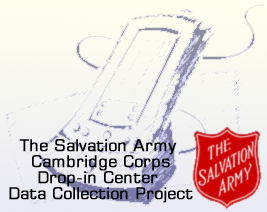

|

|

|

|

|

|

|

|

|
 The Salvation Army in
Cambridge provides a large array of services to the homeless
population in Cambridge through its drop-in center and emergency
shelter. Unfortunately, The Salvation Army collects very little
information on the majority of its clients and how they use its
services. This problem, not unique to The Salvation Army, is largely
due to the inadequacy of information-management systems used by
homeless services providers.
The Salvation Army in
Cambridge provides a large array of services to the homeless
population in Cambridge through its drop-in center and emergency
shelter. Unfortunately, The Salvation Army collects very little
information on the majority of its clients and how they use its
services. This problem, not unique to The Salvation Army, is largely
due to the inadequacy of information-management systems used by
homeless services providers.
The case of The Salvation Army is an example of the larger problem of inaccurate and incomplete data on homelessness. This lack of data is one of the major barriers to improving policies and programs designed to combat the root causes of homelessness. For example, research is already being done to find links, if any exist, between homelessness and health-related issues, or homelessness and educational level. But in the absence of adequate hard data, the results are often questioned, and consequently, increased support for the homeless in these areas is not forthcoming.
Information on how homeless individuals use social services (like those provided at The Salvation Army), especially when correlated with individual demographic information, could therefore be very valuable information for homeless services providers and for researchers attempting to learn more about homelessness. Consequently, The Salvation Army in Cambridge has identified an improved information-management system as a significant need.
When The Salvation Army met up with some MIT student volunteers during the MIT Graduate Student Volunteer Day, the assistance of the volunteers was sought to develop a system that would enable The Salvation Army to capture this potentially important data. We are the MIT team that was formed to help them design and build this system.
The idea to provide all shelter clients with a bar-coded "discount card" is the brainchild of Leo Lloyd, Director of Operations for The Salvation Army Cambridge Corps. It allows for card-carrying shelter clients to be efficiently scanned into an in-house database whenever they receive services like a meal or bed for the night. In order to access many of these services, clients currently are required to sign in using a paper and pencil. The new system would replace this existing process, producing electronic data which can be used for research and analysis.
To ensure that the card is well received, The Salvation Army will be working with other community partners to provide benefits like meal discounts and free MBTA travel with the use of the card. Further care will be taken to ensure that in its deployment, the interests of the homeless will be protected at all times.
The MIT team, after verifying the technical feasibility of this system, built the system over a period of 15 months and the system was deployed at The Salvation Army in August 2003. The goal of our involvement is to ensure that a homeless shelter (like The Salvation Army) is equipped to collect data as accurately and reliably as possible, so that we can better understand how best to serve the needs of the homeless.
If you would like more information on this project, please contact either Ben Leong or Jijon Sit. We also welcome feedback and suggestions.
This page is maintained by Roger Moh. Last updated on October 11, 2003.